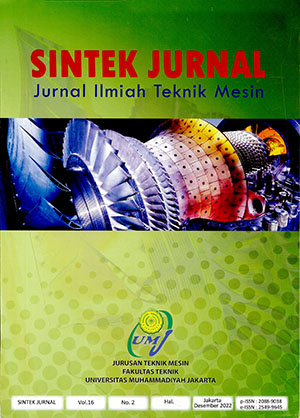Observation of macro surface and gear mass of 3d printing machine using pla filament
Main Article Content
Abstract
Article Details
- Articles published in SINTEK JURNAL are licensed under a Creative Commons Attribution-ShareAlike 4.0 International license. You are free to copy, transform, or redistribute articles for any lawful purpose in any medium, provided you give appropriate credit to the original author(s) and SINTEK JURNAL, link to the license, indicate if changes were made, and redistribute any derivative work under the same license.
- Copyright on articles is retained by the respective author(s), without restrictions. A non-exclusive license is granted to SINTEK JURNAL to publish the article and identify itself as its original publisher, along with the commercial right to include the article in a hardcopy issue for sale to libraries and individuals.
- By publishing in SINTEK JURNAL, authors grant any third party the right to use their article to the extent provided by the Creative Commons Attribution-ShareAlike 4.0 International license.
References
Amy Hurst, 2019. Fabrication, 3D Printing, and Making. New York University.
New York City. USA. Springer Nature. 755-772.
Amrullah, Muhammad Abdul Malik and Alfi, Ikrima, 2018. Rancang Bangun Prototipe Printer 3 Dimensi (3D) Tipe Cartesian Berbasis Fused Depositon Modelling (FDM). Tugas Akhir Universitas Teknologi Yogyakarta Indonesia.
Anief Awalia, Nurul Amri, dan Wirawan Sumbodo, 2018. Perancangan 3D.
Printer Tipe Core XY Berbasis Fused Deposition Modeling (FDM) Menggunakan Software Autodesk Inventor 2015. Jurnal Dinamika Vokasional Teknik Mesin. Voleme 4 Nomor 2. Hal 110-115.
Bret M. Boyle, Panupoan T. Xiong, Tara E. Mensch, 2019. 3D Printing Using Powder Melt Extrusion. Journal Additive Manufacturing. Elsavier. Page 1-27.
C. Buchanan, L. Gardner, 2019. Metal 3D printing in construction: A review of methods, research, applications, opportunities and challenges. Journal of Engineering Structures 180. Elsavier . Page 332-348.
Chaofan Gou, Min Zhang, and Bhesh Bhandari, 2019. Model Building and Slicing in Food 3D Printing Processes A Review. Journal Food Science and Food Safety. Volume 18. Page 1052-1069.
Gaoyuan Ye, Hongjie Bi, Licheng Chen, dan Yingcheng Hu, 2019. Compression and Energy Absorption Performances of 3D Printed Polylactic Acid Lattice Core Sandwich Structures. Journal of 3d Printing And Additive Manufacturing. Volume 6. Number 6. 1-11.
Hamid Abdillah dan Ulikaryani, 2019. Aplikasi 3D Printer Fused Deposite Material (FDM) Paa Pembuatan Pola Cor. SINTEK Jurnal Ilmiah Tekni Mesin. Volume 13. No.2. 110-115.
Ian Gibson and Amir Mahyar Khorasani, 2019. Metallic Additive Manufacturing: Design, Process, and Post-Processing. Journal Metals. Volume No.137.
Joe Larson, 2013. 3D Printing Blueprints. Packt Publishing Ltd. Livery Place Birmingham. UK.
Mansaf Alam, Kashish Ara Shakil, Samiya Khan, 2020. Internet of Things (IoT): Concepts and Application. Springer Naturre. Switzerland AG.
Nurhalida. Shahrubudin, T.C. Lee, R. Ramlan, 2019. An Overview on 3D Printing Technology: Technological, Material, and Applications. 2nd International Conference on Sustainable Materials Processing and Manufacturing. 1286-1296.
Redwood Ben, Schoffer Filemon, Garret Brian, 2017. The 3D Printing Handbook: Technologies, Design, and Application. 3d HUBS.
Seong Je Park, Ji Eun Lee, Han Bit Lee, Jeanho Park, Nak-Kyu Lee, Yong Son, Suk-Hee Park, 2019. 3D Printing of Bio-Based Polycarbonate and Its Potential Applications in Ecofriendly Indoor Manufacturing.Journal Additive Manufacturing. Elsavier.


